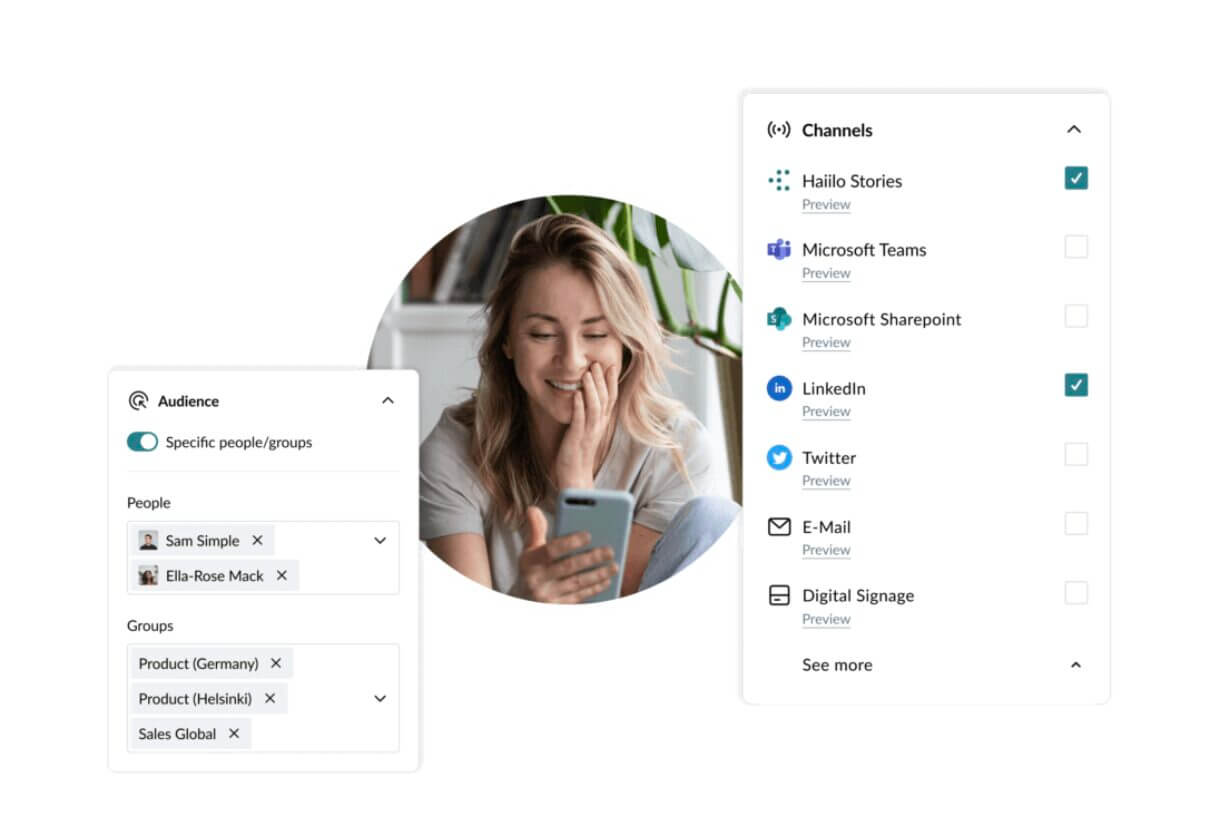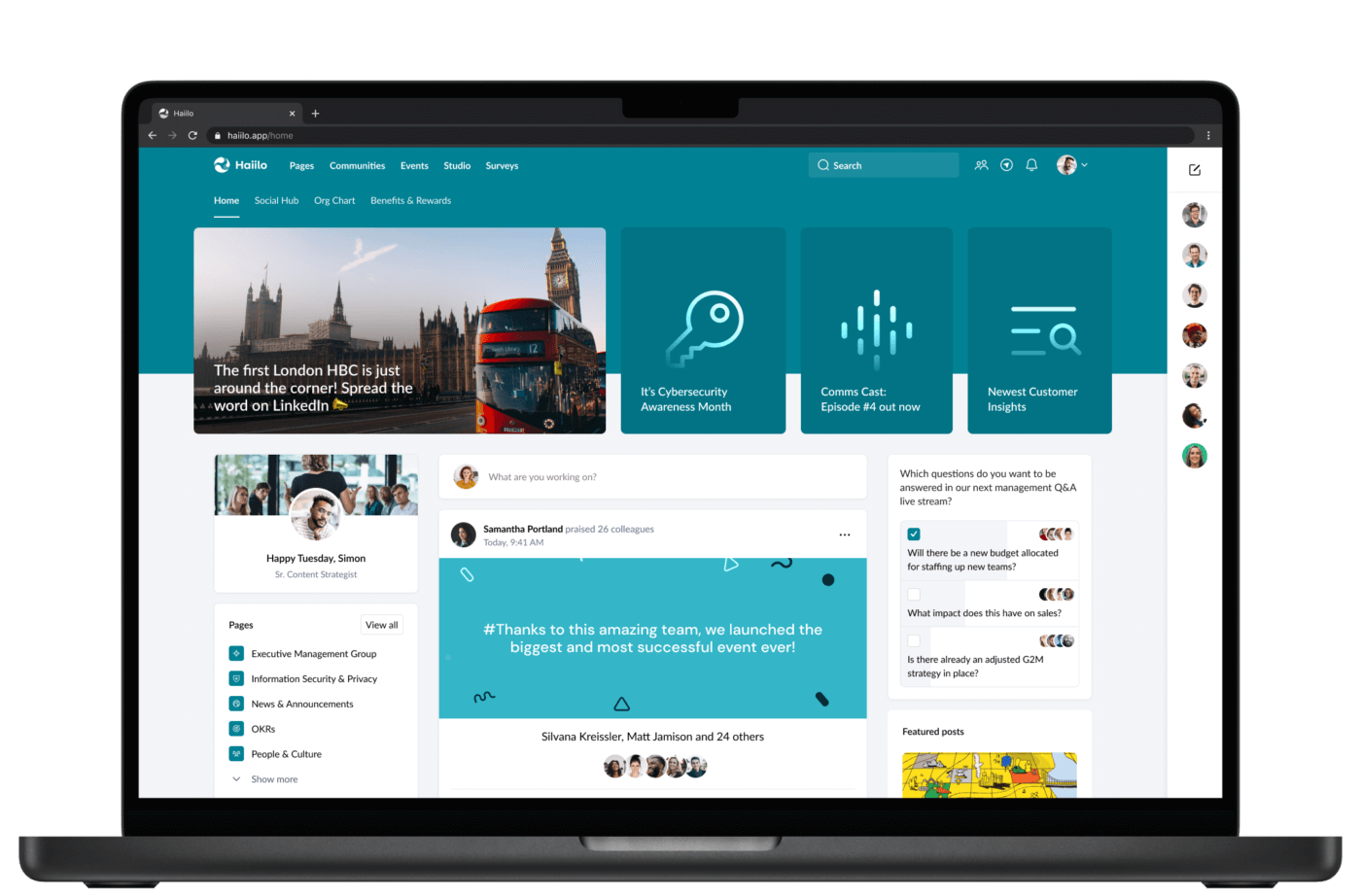Intranet user experience (UX) plays a critical role in shaping how employees interact with workplace tools, documents, information, and people.
Whether it’s fostering collaboration, sharing knowledge, or aligning with corporate values, a well-designed intranet can make a significant difference in employee productivity and satisfaction. In fact, intranet UX plays a critical role in shaping a positive digital employee experience.
However, many businesses still struggle with choosing or building an intranet that truly engages users. Deloitte’s survey found that just 38% of workers reported feeling satisfied or very satisfied with workplace tools.

In this blog, we’ll explore why intranet UX is so important and how organizations can ensure the best intranet UX.
Why Intranet UX Matters
When we think about a successful intranet, user experience should be at the top of the priority list. According to a Forrester report, 50% of employees find it difficult to locate information using their company’s intranet, a clear indicator of poor user experience. This frustration can lead to reduced productivity and lower employee engagement.
A great intranet is much more than just a set of various features; it ensures that employees can find what they need easily, collaborate effectively, and stay engaged with the company’s mission. According to McKinsey research, an effective intranet design can boost productivity by up to 35%.
Key benefits of good intranet UX
Intranet UX has a significant impact on shaping the overall employee experience in the workplace. According to Gitnux, 63% of organizations use an intranet to enhance employee engagement.
So when intranet user experience is great, organizations usually see:
- Increased intranet adoption: The intuitive interface reduces the time spent on training and increases employees’ willingness to actively use the platform
- Increased employee engagement: When the adoption rates soar, employees are more likely to use the platform to access company news, updates, and resources.
- Enhanced collaboration: A well-designed intranet fosters collaboration by making it easier for teams to connect, share documents, and communicate.
- Improved productivity: Easy navigation and powerful search mean employees can quickly find the tools and information they need, reducing wasted time.
- Better knowledge management: A seamless UX allows knowledge to be easily organized, stored, and accessed by anyone within the company.
Learn more about Haiilo’s best-in-class UX!
The cost of bad intranet UX
In contrast, poor intranet UX can create bottlenecks and frustration. When information is hard to find or platforms are too difficult to navigate, employees become disengaged. The Harvard Business Review estimates that an employee spends 2.5 hours a day searching for information, which adds up to a staggering 30% of their workday. If your intranet isn’t designed with the user in mind, this inefficiency will erode employee productivity, motivation, and morale.
Additionally, poor intranet design can create many communication barriers. When employees don’t have timely and easy access to important updates or conversations, they may miss critical information, leading to costly mistakes and missed opportunities.
Last but not least, poor intranet UX can significantly impact employee onboarding. According to Forrester, when intranets are effectively used, organizations can decrease employee onboarding time by an average of 20%.

How to Improve Intranet UX
Improving the user experience of your employee intranet requires a thoughtful approach to design, functionality, and user needs. Here are some steps organizations can take to create a more effective intranet UX.
1. Focus on user-centric design
The best intranets on the market are built using a user-centric design that prioritizes employee needs and behaviors. This means understanding how employees use the platform and designing a system that makes those tasks easier. These intranets are easy to set up, deploy, and manage, as they follow a simple drag-and-drop approach in their systems.
What to look for?
- Gather employee feedback: Start by asking employees what they need from the intranet. Understanding their pain points and desires will help you create a solution that serves them.
- User personas: Create different user personas based on departments, roles, and needs. This ensures that the intranet serves various functions and later enables communicators to deliver personalized content.
- Employee journey mapping: Track how employees interact with the intranet. This will highlight any bottlenecks or areas where the experience could be improved. Ideally, intranet dashboards and analytics should give valuable insights about daily intranet usage.
The best intranet platforms come with built-in employee listening functionalities. With Haiilo, you can attach a simple question to every piece of content you post on your intranet. These insights from your employees can help you understand their overal experience with the intranet platform.
2. Simplify navigation and search
A common problem with many intranets is that information is buried deep within the system, making it difficult to find what employees need. The solution is to streamline navigation and improve search functionality to help employees locate information quickly and easily.
What to look for?
- Intuitive menu structure: A clear, simple menu structure that categorizes information in a way that makes sense for your workforce.
- AI-powered search: A search function that analyzes employees’ inquiries, crawls internal documentation, and provides complete answers or links to relevant documents.
Check out how Haiilo’s AVA integrates with your search! 👇
- Bookmarking: Saving posts on the timeline by bookmarking them. This allows employees to easily find and revisit content when it’s most convenient for them. It also helps employees create a personal knowledge hub of content that they’d like to be able to quickly access.
The best solutions out there have powerful, AI-powered search engines that make finding content fast and easy. Whether employees are looking for specific documents, updates, or colleagues, your intranet should ensure that everything is just a few clicks away.
3. Integrate with existing tools
Some of the most important intranet best practices include integrations. An intranet should never exist in isolation. Integrating the platform with tools that employees already use can significantly improve UX. Seamless integration with communication apps, project management tools, and document storage solutions keeps everything connected.
What to look for?
- Single Sign-On (SSO): Implement SSO to reduce the number of logins employees need, making it easier to access the intranet alongside other business tools.
- App integration: Ensure the intranet integrates with collaboration tools like Slack, Office 365, email, Google Workspace, and even SMS.
- Active Directory or LDAP: Enable teams to effectively manage users, computers, additional devices, and other resources from one central location, making network, IT, and security management more efficient.
- HRIS integrations: Allows teams to request time off, displayes unused vacation time.

To improve intranet UX, the solution should integrate with a variety of business tools, from communication channels to project and document management systems. Haiilo’s goal is to create a digital workspace that fits seamlessly into an employee’s daily routine, eliminating unnecessary friction and boosting productivity.
4. Personalization and customization
No two employees work the same way, and a one-size-fits-all approach rarely works for intranets. By offering digital personalization and customizable intranet features, organizations can deliver relevant content to users based on their role, location, or department.
Customization is particularly important to admin users. Being able to customize the platform to fit into the existing business workflows is critical for ensuring a great admin experience.
What to look for?
- Role-based permissions: Being able to define specific rights and permission levels for individuals, groups, or departments.
- Approval processes: Streamline approval processes to make content production and distribution seamless and agile while following the existing hierarchy and business procedures.
- Content segmentation: Allow users to subscribe to different content channels based on their interests, and use robust segmentation capabilities to build target audiences.
Intranets with the best UX emphasize and prioritize personalization. By creating a more relevant experience and targeted multichannel communications, they help increase employee engagement and satisfaction.
5. Mobile optimization
With more employees working remotely or on-the-go, mobile access to the intranet is essential. A mobile-friendly intranet ensures that employees can stay connected and productive, regardless of location or device.
What to look for?
- Mobile-first design: Ensure the intranet is designed with mobile in mind, offering a responsive layout that adjusts to different screen sizes.
- Mobile apps: Provide dedicated mobile apps for Android and iOS, giving employees quick access to important content and tools from their smartphones.
- Cross-device syncing: Make sure the intranet syncs across devices so that employees can start a task on one device and finish it on another without losing progress.
Best intranet UX offers a fully mobile-optimized intranet platform designed with frontline workers in mind. Whether employees are in the office, at home, or in the field, they can easily access important information and stay engaged with their teams.
6. Measure and improve
The key to continuous improvement is measurement. By regularly analyzing user data and feedback, businesses can identify areas of the intranet that need enhancement. A data-driven approach ensures the platform evolves with the changing needs of the workforce.
What to look for?
- User analytics: Track how employees use the intranet, including page views, click-through rates, and time spent on different sections. This data will show which features are being used and which may need improvement.
- Employee listening: Regularly gather feedback from employees to identify pain points and opportunities for improvement or simply capture their feedback about any workplace-related topic.

- A/B testing: Use A/B testing to try different designs, layouts, or content strategies to see what resonates best with users.
Best-performing intranets include built-in analytics tools, allowing organizations to monitor user engagement and platform performance. This helps businesses make data-driven decisions to improve the intranet experience continually.
Launching an Intranet with the Best-In-Class UX
A well-designed intranet UX is more than a nice-to-have—it’s essential for employee engagement, productivity, and overall organizational success.
By focusing on user-centric design, simplifying navigation, integrating with existing tools, and leveraging Haiilo’s cutting-edge platform, businesses can create an intranet that truly meets the needs of their workforce.
At Haiilo, we understand the importance of delivering a great user experience. Our platform offers the tools and flexibility businesses need to create an intuitive, engaging, and productive intranet environment. Ready to launch an intranet with best-in-class UX?










